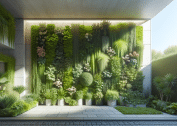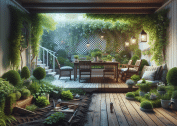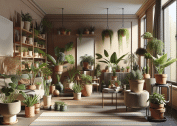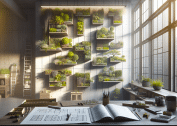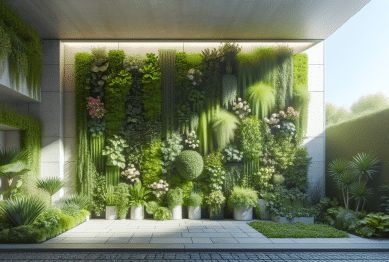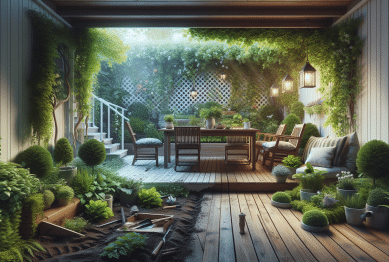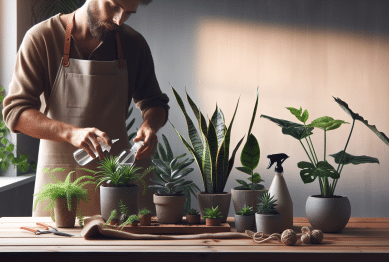Feeling cramped at home? Discover how strategic interior design, clever furniture choices, and lighting tricks can create a more spacious atmosphere. Unlock practical tips to maximize small spaces so your home feels airy and comfortable without major renovations.
Understanding Space Perception in Home Design
Have you ever wondered why some rooms feel inviting and spacious, while others seem tight? The perception of space in home design is about more than just square footage. Clever visual techniques and functional organization make all the difference. For many, maximizing vertical space with tall shelving or mounting artwork draws the eye upward, adding height and openness. Light, neutral paint on walls, such as whites, creams, and pale greys, reflect sunlight and artificial lighting, amplifying a sense of airiness. When you pay attention to how color, arrangement, and storage interact, small spaces suddenly appear generous and welcoming.
Natural light is the secret weapon of spacious-feeling interiors. Large windows, open shades, and strategically placed mirrors bounce sunlight through rooms, reducing shadows and visually extending boundaries. If natural light is limited, consider installing layered lighting—overhead fixtures, task lamps, and floor lights—to evenly brighten corners and expand the feel of any space. Gloss or satin finishes on surfaces also help by reflecting more light, producing a subtle shimmer that draws attention away from clutter or tight layouts. Every design decision, from finishes to fixtures, contributes to the experience of a bigger home.
What about items you can’t see? Hidden storage is one of the most effective methods to conquer clutter, the main foe of open space. Storage ottomans, beds with drawers, and benches with lift-up seats tuck away personal belongings without consuming precious real estate. Multi-use furniture, like sofa beds or desks that fold into the wall, transforms single-purpose areas into adaptable zones, making even compact homes versatile and functional. Strategic organizing keeps essential items accessible and allows rooms to flow freely—so space works for you, not against you.
Furniture Choices That Transform Small Rooms
Choosing the right furniture can dramatically shift how spacious a room feels. Bulky, oversized pieces overwhelm small homes, creating obstacles that break up flow. Instead, opt for slim-profile couches, glass-top tables, and floating shelves. These features invite movement, revealing more floor area and giving the illusion of a larger footprint for living rooms or bedrooms. Lighter-toned woods, metals, and acrylics also minimize visual weight. One proven option is sectional sofas that hug corners, maximizing seating without hogging valuable space.
Multi-functional furniture is another powerful tool for compact dwellings. Consider a dining table with built-in extension leaves, or benches that double up as storage units. Murphy beds, fold-down desks, and stackable chairs provide versatility and efficiency. These pieces adapt to changing needs—ideal for small apartments, home offices, or rooms that serve multiple purposes. When furniture supports both function and flexibility, spaces become resilient to clutter, and every square foot is put to work thoughtfully.
A trick of the trade: Legs matter. Furniture on exposed legs gives the appearance of floating in a room, helping light move underneath and around each piece. In contrast, pieces that sit flush to the floor visually absorb the area. Prioritize open or leggy designs for sofas, chairs, and coffee tables to increase the sense of airiness. Clear furniture madeof glass or Lucite almost disappears into the decor, expanding boundaries without adding physical mass. Small design choices like these add up to big spatial impact.
Lighting Tactics to Enlarge Your Living Space
Lighting is an unsung hero in interior design, especially for making small spaces seem larger. Layering ambient, task, and accent lighting allows you to control focus, emphasize features, and keep dark areas at bay. Start by maximizing existing daylight, then supplement with wall sconces and under-cabinet LEDs to highlight surfaces and create depth. Placement matters—a well-lit corner instantly recedes visually, making walls feel farther apart. For homes shy on daylight, using daylight-mimicking bulbs invites the vibrancy of the outdoors inside.
Mirrors rank among the most effective lighting companions. Hanging a large mirror directly across from a window channels natural light into deeper parts of a room. Mirrored furniture or decorative panels multiply reflections, striking balance between style and utility. Even a small mirror on a shelf can brighten dull nooks by scattering light in unexpected ways. It’s a simple, cost-effective upgrade that delivers outsize visual results.
Consider dimmers for adjustable ambiance that suits every moment. Dimmers let you fine-tune lighting, shifting from bright and energizing during the day to cozy and relaxing in the evenings. Accent lamps draw attention to vertical lines—such as bookshelves or plants—making ceilings appear higher. The interplay of brightness and shadows shapes how a room feels, dramatically improving both form and function without renovating walls or knocking down partitions.
Decluttering and Smart Storage Solutions
Decluttering is one of the simplest ways to make a home feel more expansive. Every unneeded item absorbs attention and occupies space physically and visually. Start with a room-by-room sweep, identifying belongings that add purpose or joy. Donate, sell, or recycle what you no longer use. This practical approach frees not just surfaces and storage areas but also brings peace and mental clarity, creating a more inviting interior.
Once you’ve cleared out excess, smart storage can maintain a sense of order. Use baskets and bins to group similar items, place shelves above doors or along unused nooks, and add hooks for coats or bags behind doors. Vertical organizers—whether tall bookshelves or pegboards—take advantage of height, drawing the eye upwards as they keep everyday essentials accessible. Remember: less visible clutter equals a greater sense of openness and ease.
Built-in solutions such as banquettes with lift-top seating or cabinetry stretching to the ceiling save precious floor area. Modular storage that adapts to shifting needs—like cubes, stackable bins, or adjustable shelving—works well as life changes and spaces evolve. For renters or temporary setups, non-permanent options like hanging organizers, mobile carts, or collapsible containers keep areas calm and free-flowing. Simple storage swaps pack a big punch in maximizing a small home’s potential.
Visual Tricks With Color and Decor Elements
Color is an affordable tool in any design toolbox. Lighter hues make walls fade, recede, and visually open up cramped quarters. Whites, off-whites, soft blues, and green tints are popular choices for making spaces appear expansive. Keeping trims, moldings, and doors painted the same color as walls avoids harsh visual breaks, ensuring an uninterrupted flow. The effect: boundaries blur, and even compact rooms seem to breathe.
Decor plays a subtle but vital role in spatial transformation. Choose just a few large art pieces instead of many smaller ones—this gesture reduces visual clutter and creates focal points. Hang curtains closer to the ceiling and allow them to drop to the floor. This optical illusion heightens walls and increases grandeur, especially in rooms with lower ceilings. Minimalist rug patterns and transparent accessories maintain interest and energy without overwhelming limited square footage.
Bring a piece of nature inside! Houseplants add a lively, organic element, and vertical gardens or hanging planters save both surface and floor area. Consider reflective materials like metallics, glass, and gloss paint to infuse sparkle and movement into a room. Thoughtful use of decor, from oversized mirrors to slimline lamps, transforms the ordinary into something extraordinary. These small design choices create big shifts in perception, making any home feel larger, brighter, and more inviting.
Creating Flow With Open Layouts and Zoning
Open-plan living is a popular trend for its ability to create seamless flow between spaces. While removing walls is not always possible, there are creative tricks to achieve the same effect. Use area rugs, couch placement, and furniture groupings to define function—dining, relaxing, working—within a shared room. This approach maintains visual unity while giving each zone a clear identity, ensuring spaces feel connected but distinct.
Sliding partitions, shelving units, or curtains can serve as flexible dividers, allowing privacy when needed and openness when not. These elements keep sightlines clear, letting rooms unfold without abrupt stops. Even a thoughtfully placed open bookshelf can draw a gentle boundary without creating a sense of confinement. Zones should encourage movement, avoid awkward paths, and invite natural circulation so the entire home feels accessible and cohesive.
The psychology of flow is transformative. When sightlines extend from one area to the next, rooms feel bigger and airier. Interruptions like half-walls or glass panels add a touch of division without closing off space. By prioritizing gentle transitions instead of solid barriers, even the smallest homes appear to expand. Flow isn’t about removing rules—it’s about maximizing movement, enhancing experience, and turning every inch into a part of harmonious living.
References
1. American Lighting Association. (n.d.). Lighting Basics: Creating the Illusion of Space. Retrieved from https://www.americanlightingassoc.com/lighting-tips/lighting-basics
2. The Spruce. (2023). How to Make a Room Look Bigger. Retrieved from https://www.thespruce.com/how-to-make-a-room-look-bigger-2213454
3. Good Housekeeping. (2023). Small Living Room Ideas That Maximize Space. Retrieved from https://www.goodhousekeeping.com/home/decorating-ideas/g2720/small-living-room-ideas
4. National Association of Home Builders. (n.d.). Maximizing Small Spaces. Retrieved from https://www.nahb.org/homeowners/homeownership/maximizing-small-spaces
5. Architectural Digest. (2023). Smart Storage Solutions for Compact Spaces. Retrieved from https://www.architecturaldigest.com/story/small-space-storage-ideas
6. Better Homes & Gardens. (2023). 12 Tricks to Make a Small Room Look Bigger Instantly. Retrieved from https://www.bhg.com/decorating/small-spaces/strategies/make-small-room-look-bigger


